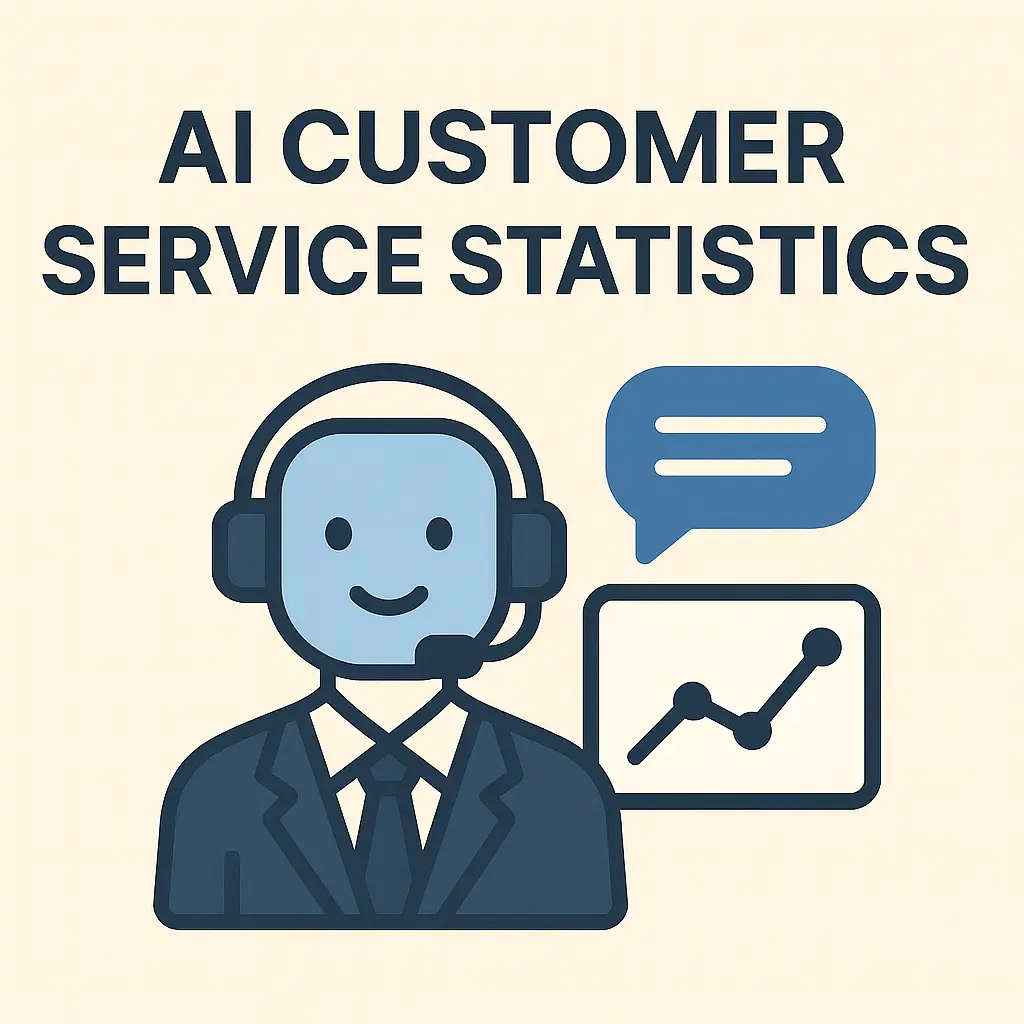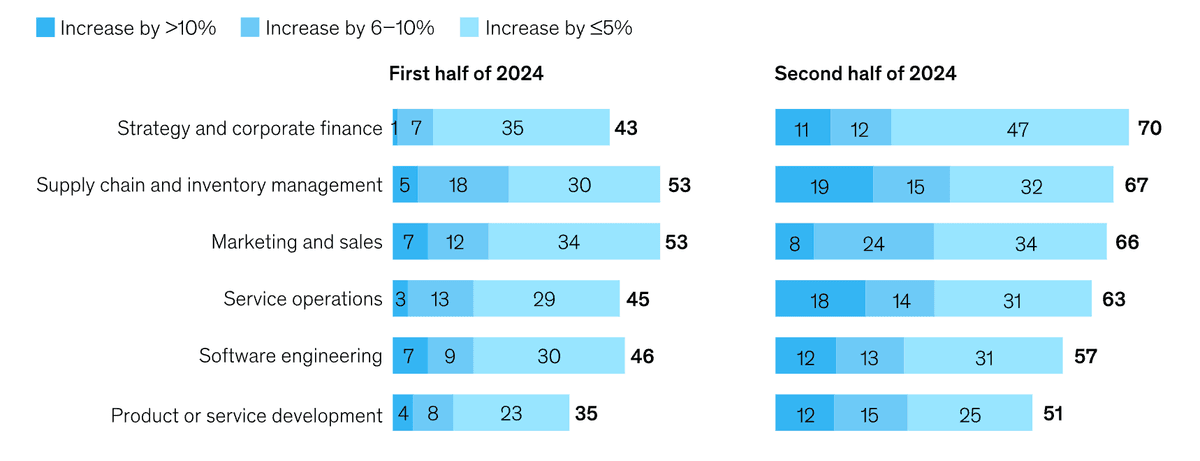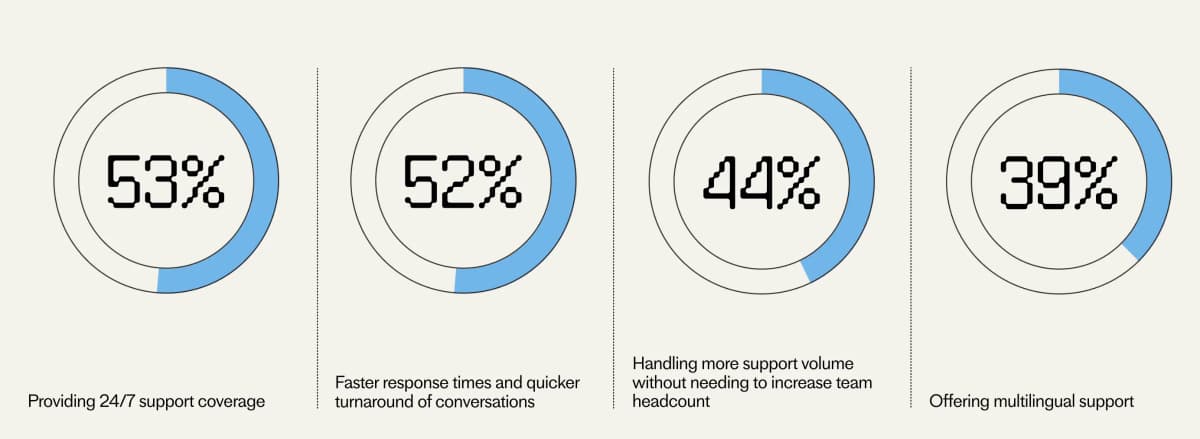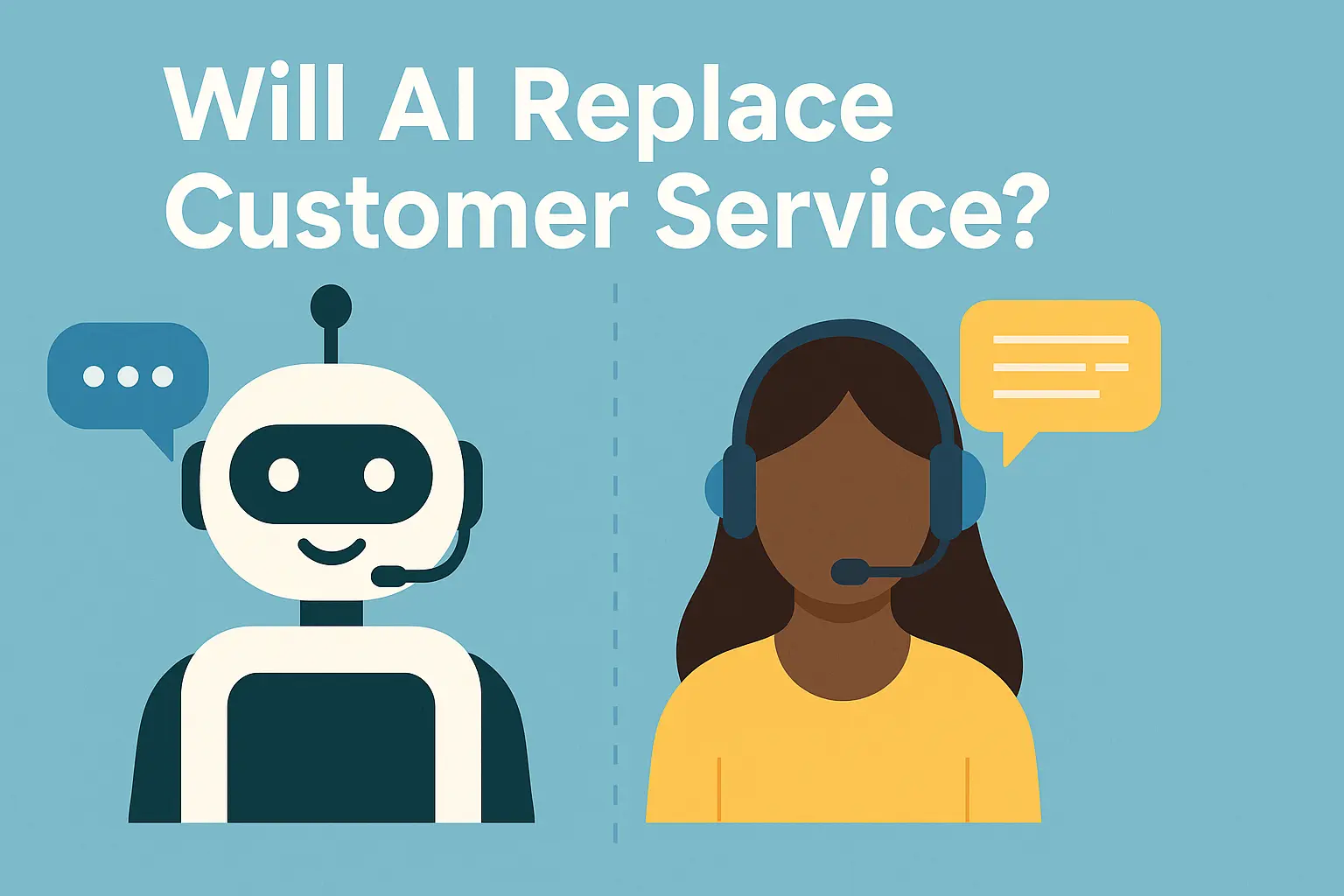20+ AI Customer Service Statistics (2025)
Explore these 20+ AI Customer Service Statistics of 2025

AI isn’t just a buzzword anymore, it’s redefining customer service.
From instant replies to personalized experiences and cost-saving automation, AI is transforming how businesses connect with their customers. The shift is happening fast, and the numbers tell the story better than anything else.
Below, you’ll find up-to-date statistics on AI in customer service, covering everything from customer satisfaction and business growth to adoption trends and ROI. Each stat comes with a quick breakdown so you can see exactly why it matters, what it means for your business, and how it’s reshaping the future of support.
Let’s dive into the data that shows why AI is no longer optional, it’s the new standard in customer experience.

1. 80% of customers who interacted with AI in customer service reported a positive experience.
The numbers speak for themselves.
Most customers walk away satisfied after engaging with AI-driven support. Why? Because AI systems can handle simple questions instantly, personalize responses using customer data, and reduce the frustration of long wait times.
This creates a smoother, more efficient journey that customers appreciate.
For businesses, it’s proof that investing in AI isn’t just about cutting costs, it’s about delivering the kind of fast, tailored support that builds loyalty.
2. The global conversational AI market is projected to reach $41.39 billion by 2030.
By the end of the decade, conversational AI will be a $41+ billion industry.
From chatbots to virtual assistants, its growth signals just how essential AI-powered conversations have become in customer service, sales, and engagement strategies worldwide.
For businesses, the takeaway is clear: conversational AI is no longer a side experiment, it’s becoming a core driver of value and a market too big to ignore.
3. A good AI experience can raise customer satisfaction by up to 20%.
When customers feel heard and helped quickly, they come back.
AI makes that possible by delivering tailored recommendations, instant answers, and round-the-clock assistance. The result? A measurable boost in satisfaction, up to 20%.
That kind of lift can mean the difference between a frustrated one-time buyer and a loyal repeat customer. For businesses, it’s clear: investing in AI-powered support is investing in long-term relationships.
4. Companies that offer excellent customer experience (often boosted by AI) grow revenues 4–8% faster than their competitors.
Customer experience isn’t just about keeping people happy, it’s directly tied to growth.
Businesses that excel here, often through AI-powered support, see revenue gains well above the competition. The reasons are clear: happy customers buy more, stay longer, and recommend brands they trust.
AI helps make that possible by streamlining service, anticipating needs, and personalizing interactions at scale. For companies, the payoff is bigger than efficiency—it’s faster growth, stronger loyalty, and higher long-term profits.
5. 62% of consumers would rather use a chatbot than wait for a human customer service agent.
Speed is king in customer service.
Most people don’t want to wait in long queues or be put on hold—they want answers now. That’s where AI shines. A well-trained chatbot can respond in seconds, no matter the time of day, removing the friction that often drives customers away.
For businesses, this means faster resolutions, happier customers, and fewer abandoned carts or tickets. The lesson? If your chatbot can deliver speed without sacrificing accuracy, the majority of your customers will happily choose it over waiting for a human.
6. 73% of shoppers believe AI could improve their customer experience.
Customers don’t just want answers, they want them tailored to their needs, fast and available 24/7.
That’s why nearly three-quarters of shoppers believe AI has the power to transform their experience. With instant responses, personalized recommendations drawn from data, and round-the-clock availability, AI bridges the gap between efficiency and empathy.
The takeaway?
Shoppers increasingly see AI not as a cold replacement for humans, but as a smart upgrade to the service they already expect.
7. 63% of retail companies are already using AI to enhance customer service.
In retail, AI adoption is already the norm.
Nearly two-thirds of companies are using it to boost service—whether through chatbots that handle customer queries or recommendation engines that drive purchases. Many are even creating specialized AI teams and budgets to stay competitive.
The message is obvious: AI is quickly becoming table stakes. Falling behind means losing customers to rivals who are faster, smarter, and more responsive.
8. AI chatbots can reduce the need for live agents by up to 68% during peak times (and 51% on average year-round).
When customer demand spikes, human agents often struggle to keep up.
AI chatbots step in to handle the bulk of routine inquiries, cutting agent workload by more than half and by nearly 70% during busy periods. This frees up human staff to focus on complex, high-value interactions while ensuring customers still get fast responses.
For businesses, the result is a leaner, more efficient support system that scales effortlessly with demand.
9. For every $1 companies invest in AI, they’re seeing an average of $3.5 back, and some are hitting $8.
That’s not hype, that’s math.
Most companies are more than tripling their money when they put it into AI. And the top performers? They’re getting an $8 return for every dollar spent.
That kind of ROI doesn’t just pay for the tech—it funds growth, frees up budget for new projects, and proves AI isn’t just a shiny tool, it’s a business multiplier.
10. Conversational AI could cut $80 billion in annual customer service labor costs by 2026.
The financial stakes are massive.
Conversational AI isn’t just improving efficiency—it’s reshaping the economics of customer service. By automating routine inquiries and scaling support without adding headcount, businesses worldwide could save tens of billions each year.
For companies, this isn’t just about trimming budgets; it’s about reallocating resources toward growth, innovation, and higher-value customer interactions. Those who adopt conversational AI early stand to capture the lion’s share of these savings.
11. Organizations using AI in customer service saw about a 35% reduction in operating costs and roughly a 32% increase in revenues, on average.
AI isn’t just about faster responses, it’s reshaping the bottom line.
Companies that integrate AI into their support see costs drop significantly, as automation takes over repetitive tasks and reduces reliance on large support teams. At the same time, revenues climb, thanks to better customer experiences, higher retention, and smarter upselling.
For businesses, the message is clear: AI in customer service isn’t just an efficiency tool, it’s a growth engine that improves both sides of the profit equation.

12. Companies using AI had a 36% increase in repeat purchases compared to those without automation.
AI is shaping customer loyalty.
By remembering past interactions, tailoring recommendations, and delivering consistent experiences, AI creates a smoother journey that encourages customers to come back. Businesses that use AI see significantly higher repeat purchases.
For companies, the takeaway is clear: smart automation doesn’t just close a deal—it keeps the door open for the next one.
13. 64% of business owners believe AI will improve customer relationships.
Trust in AI is growing, especially among business leaders.
Nearly two-thirds of owners now see AI as a way to deepen customer relationships rather than weaken them. Why? Because AI enables faster responses, smarter personalization, and proactive support that keeps customers engaged. It’s not just about efficiency; it’s about creating the kind of loyalty and retention that drives long-term growth.
For businesses, the takeaway is clear: customers aren’t the only ones expecting AI, leaders are betting on it too.
14. 25% of companies will rely on chatbots as their primary customer service tool by 2027.
Chatbots aren’t just an add-on anymore. They’re becoming the backbone of customer support strategies. Within the next two years, a quarter of all companies are expected to make chatbots their main channel for handling customer inquiries. This shift reflects both customer demand for instant, 24/7 responses and businesses’ drive to scale support without inflating costs.
For companies, the message is clear: investing in chatbot technology now means being ready for a future where AI isn’t just assisting agents, it’s leading the conversation.
15. 56% of business owners are already using AI-powered solutions in customer support.
More than half of business owners have already made the leap to AI-driven support.
From delivering instant responses to tailoring interactions with customer data, AI is quickly becoming the standard, not the exception. This widespread adoption shows that companies aren’t waiting around to see if AI works, they’re already reaping the benefits.
For businesses still on the fence, the message is clear: the competition is moving fast, and falling behind could mean losing customers to brands that deliver smarter, faster, and more personalized service.
16. 85% of customer service and support leaders plan to pilot conversational generative AI by the end of 2025.
An overwhelming majority of customer service executives say they’ll be piloting conversational generative AI within the next year.
That means smarter bots, faster resolution times, and more natural interactions are about to become the industry norm. For businesses, the takeaway is urgent: if you’re not exploring generative AI yet, your competitors almost certainly are. Waiting too long could leave you playing catch-up in a market that’s moving fast.
17. Companies using AI are 35% less likely to have agents overwhelmed by information overload during calls.
Customer service can be stressful.
Especially when agents are drowning in scattered data and trying to find the right answers under pressure. AI changes that dynamic. By surfacing relevant information in real time, recommending responses, and filtering out noise, AI gives agents clarity instead of chaos.
Therefore, Agents feel less overwhelmed, which means better focus, faster resolutions, and higher-quality interactions.
For businesses, this translates into more productive teams and smoother customer experiences.
18. 26% of customer service professionals have already integrated AI into their daily workflows.
AI is already part of daily life for more than a quarter of service professionals, according to the 2024 IBM Global AI Adoption Index.
From using AI to draft responses, summarize customer interactions, or prioritize tickets, these tools are quietly reshaping how support teams operate. For businesses, this signals a turning point: AI in customer service is moving from “pilot projects” to everyday practice. Those who aren’t experimenting risk missing the wave as their peers build efficiency and expertise.
19. Companies using AI see tickets resolved 52% faster compared to those relying on manual workflows.
AI transforms support speed.
By automating repetitive tasks, routing tickets intelligently, and providing instant answers, AI slashes resolution times nearly in half. That means customers spend less time waiting and more time getting value from your product or service.
For businesses, this means: faster resolutions, lower support costs, boost satisfaction, and free agents to handle more complex cases that strengthen customer relationships.

20. Human Agents with the help of AI handle 13.8% more inquiries per hour.
AI boosts frontline productivity. Support teams are seeing a tangible lift in output when AI steps in.
With automated tools classifying incoming requests, routing them to the right agent, and even drafting responses, AI gives back valuable time, about 1.2 hours per day per agent. The result: customer service reps can handle nearly 14% more inquiries every hour, easing pressure on teams and improving response times.
For businesses, this means higher efficiency without additional headcount, turning AI into a force multiplier for frontline support.
21. Proactive AI increases customers’ Value Enhancement Score (VES) by 9%
Proactive support, when companies reach out to address an issue before the customer asks, drives a 9% lift in Value Enhancement Score (VES). VES is Gartner’s metric that measures how much a service interaction helps customers get more value from a product and feel more confident in their choice.
For businesses, this means predictive AI doesn’t just solve problems faster—it strengthens customer trust, improves loyalty, and increases long-term growth potential.
22. 15% of contact centers already use generative AI for authentication, call summaries, and solution guidance
According to Deloitte, a growing number of contact centers are moving beyond basic automation and actively embedding generative AI into live operations. About 15% are already using it to speed up customer authentication, summarize conversations in real time, simplify solution options for agents, and even generate follow-up recommendations automatically.
For businesses, this shift signals that generative AI isn’t just experimental anymore, it’s driving measurable improvements in efficiency, accuracy, and customer experience. The payoff: faster calls, less agent fatigue, and more consistent service delivery.
Sources
Ready to Build Your AI Chatbot?
Create a smart ai chatbot for your website in just a few minutes. No coding required!
Smart AI Responses
Powered by advanced AI technology
Quick Setup
Get started in under 5 minutes
Free to Start
No credit card required

